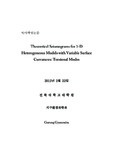Please use this identifier to cite or link to this item:
http://archive.nnl.gov.np:8080/handle/123456789/313| Title: | Theoretical seismograms for 3-D heterogeneous models with variable surface curvatures : torsional modes |
| Authors: | Gurung, Gyanendra |
| Keywords: | Surface curvature Wavefront propagation Multimode-multistructure 3-D heterogeneity Theoretical seismograms Static compuations Torsional modes |
| Issue Date: | 28-Feb-2018 |
| Abstract: | This thesis presents a new algorithm for computing theoretical seismograms for torsional modes with realistic earth models. With the availability of modern computational hardware, advanced multimode seismic procedures for 3-D mapping of realistic structures are now feasible for laterally heterogeneous structures with variable surface curvature. The fundamental assumption for modal treatment of such structures, is that each triplet (frequency, mode number, surface azimuthal direction of propagation) at a location can be assigned its own specific laterally-homogeneous structure and radius of surface curvature. The extent of the true structure used for this assignment is defined by the modal depth of penetration D, and the vertical cylinder with surface sensing-circle diameter S equal to 1.12 times this depth of penetration. In this thesis, we0 measure the accuracy of our computed parameters in terms of P significant figures (sig. fig.). The relation σ_N (ξ)=log10 [5ξ/ |δξ|] defines the significant-figure accuracy of ξ (normalized to unity). Within the fundamental assumption, the extended Himalaya is used to test quantitatively the feasibilty of the mapping procedures. In the region about a single latitude-longitude location, feasibility tests then show that: (1) relative to treating lateral heterogeneity, our method is optimally effective in resolving the structural parameters if the experimental data are accurate to 3.7 sig. fig. (a 0.005-0.010 km/s error in measured phase velocity); (2) relative to treatment of variable surface curvature in realistically anelastic structures, if the experimental data are more accurate than 2.4 sig. fig. (errors less than 0.03-0.08 km/s), the correct mode-frequency dependent radius of curvature must be used in the computations; and (3) relative to treating propagation in varying surface azimuthal directions in realistically anelastic structures, if the experimental data are more accurate than 1.7 sig. fig.(errors less than 0.20-0.80 km/s), computations must be performed as a function of azimuth for each location. With an initial 3-D structure specified, “static computations” generate a complete (torsional and spheroidal) multimode specification for each location. Standardized representations for this specification are critical to the 3-D mapping procedure: a compact, eight-parameter graphical representation is needed to monitor the network output, location-by-location. For this we use the appropriate 32 modes of frequency-dependent physical phase velocity C_1, attenuation parameter 1/Q_c, physical group velocity U_1, energy-density integral I, radius of surface curvature R, surface sensing-circle diameter S, depth of penetration D, and the ratio Ƙ=S/D. In applying the fundamental assumption during the computational procedures, we must iterate over the ratio of input S and output D to satisfy the fundamental assumption to the level σ_N (Ƙ)=3.3 sig.fig. This then ensures the computational accuracies: 5.0 sig. fig. in C_1, 4.4 sig. fig.in Q_c, 3.7 sig. fig.in U_1, 3.8 sig. fig.in I, and 4.2 sig. fig.in R. With Ƙ=1.120±0.003, computed R is good to 4.2 sig. fig.; but to obtain the desired 5.0 sig. fig.in C_1 the sufficient condition on R is 5.0 sig. fig. Fortunately, the corresponding necessary conditions are far less stringent. These depend upon the ratio D/R, and it is only forD/R ≈1 that R needs to be good to 5.0 sig. fig.; however, for the upper 800 km beneath the extended Himalaya, 0.04<D/R <0.14 and we need only 3.7<accuracy of R<4.0 sig.fig. The group velocity on a laterally heterogeneous structure with variable surface curvature, depends upon dR/ dω and dS/ dω. If these frequency derivatives are ignored, the accuracy of computed U_1 can fall to 2.4 sig. fig. Extensive comparisons of our results with those from finite-difference computations, in both the frequency and time domains, have now verified and improved our preliminary estimates of Ƙ. For propagation perpendicular to the Himalayas, we now have Ƙ=1 for (Moho) updip propagation, and Ƙ=1.25for downdip propagation, i.e. the triplet-specific extent of the true structure is essentially the hemisphere of radius D beneath the surface location. Whether this is a true directional dependence, or simply an /accuracy variation of a constant value, Ƙ=1.12±0.12, is not yet clear. Based on all the above results and our assumptions, I compute synthetic seismograms for Torsional modes. Our synthetic seismograms correspond well with results from earlier studies. Even though, a complete represention of synthetic seismograms require spheroidal modes, we however conclude this thesis with torsional mode results and investigate spheroidal modes in the future.\newline |
| Description: | Thesis for doctorate degree submitted to faculty of Chonbuk National University Graduate School, Department of Earth and Environmental Sciences, 2012. |
| URI: | http://103.69.125.248:8080/xmlui/handle/123456789/313 |
| Appears in Collections: | 500 Natural sciences and mathematics |
Files in This Item:
| File | Description | Size | Format | |
|---|---|---|---|---|
| THESIS-PHD-GGURUNG.pdf | 7.77 MB | Adobe PDF |  View/Open |
Items in DSpace are protected by copyright, with all rights reserved, unless otherwise indicated.